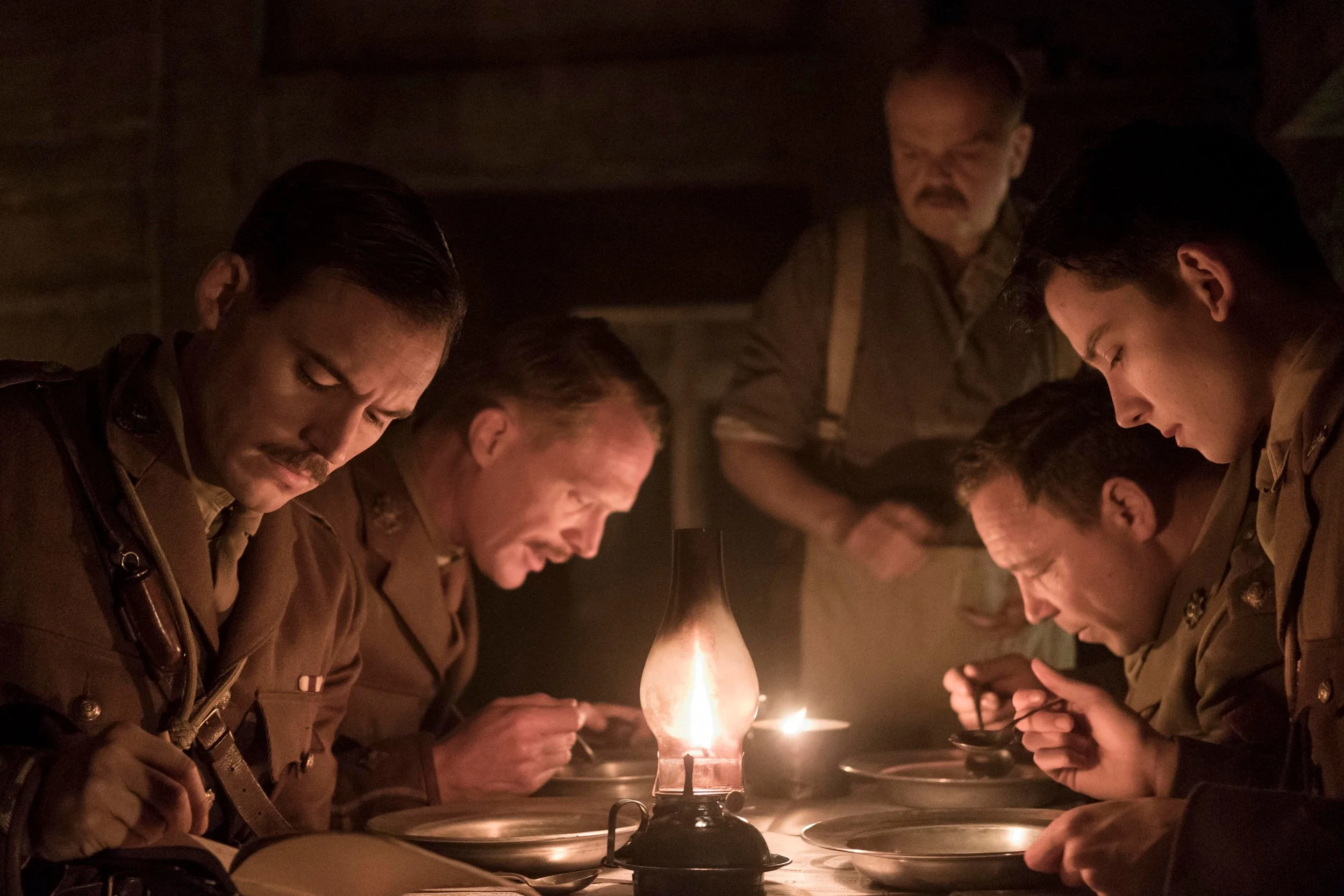MOVIE REVIEW: Journey's End
JOURNEY’S END-- 3 STARS
Innumerable war films have followed the prototypical commoner servicemen from a humble or meager background. The foot soldier. The grunt. The expendable. The rank and file. The little people. The nameless. What makes their stories compelling on the written page, lit stage, or on the silver screen is the universality that anyone of us could be them in the same scenario. We react with shared empathy. We don’t often do the same for officers in war films. All too often, the higher ranks presiding over those common men are seen as special, elitist, or protected above the worse of any war-time fray. Sometimes, they are portrayed as more severe antagonists than even the battle opponents across enemy lines.
LESSON #1: THE BURDEN OF LEADERSHIP-- Few stories examine the unseen and genuine burdens of guilt and responsibility those leaders have in carrying out the orders that can lead to troubling losses of life, including their own. The emotional weight they are forced to hold is crushing. Quite frequently, those pillars of strength can stir the same empathy as the humble and meek of the lower ranks in the same uniforms.
That’s the beauty found in the bleakness of R.C. Sheriff’s 1928 play Journey’s End. Rarely are the plights of officers given this much tangible intimacy. Sheriff’s work emerges with its first faithful film adaptation in 88 years since James Whale’s 1930 work. Director Saul Dibb (The Dutchess, Suite Francaise) brings this powerful pillar just in time for the First World War Centenary anniversary of its cited historical setting. Bolstered by strong performances and patient tension, Journey’s End is a worthy experience to join the class of All Quiet on the Western Front, Paths of Glory, Sergeant York, and Gallipoli.
Journey’s End recounts the British side of a climactic four-day span from March 18-21, 1918 in the stalemate “No Man’s Land” trenches of Aisne in northern France in the lead-up to Operation Michael. Every month, each British company is required to serve six days on the front line where casualties are gravely high. Gambling with death sentences, both trooper and officer alike pray that their six days are not the ones where an offensive is being amassed or defended.
Intelligence arrives very early that the Germans are mounting a push and the British are unprepared, meaning this is not the week anyone wants to be here. The leading officer of the moment, Captain Stanhope, played by the Me Before You’s Sam Clafin, can only hope for the best and prepare for the worst with the men that sternly follow him, including his longtime #2 Lieutenant Osborne (Paul Bettany), the trusty cook Private Mason (Toby Jones), and the more fragile Second Lieutenant Hibbert (Tom Sturridge of Far from the Madding Crowd). The visions of the things they have seen and the horror of what is to come drive Stanhope to the bottle to dull the sorrows while Hibbert tries to scheme desertion.
These experienced men have been in this position before and know what’s coming. A new arrival that does not is the fresh-faced new replacement officer, Second Lieutenant Raleigh, played by the top top-billed Asa Butterfield of Hugo and Ender’s Game. He aspires for glory without realizing the horrible reality that lies in this place of mud, gas, and death. Raleigh was a former cadet of Stanhope’s back home and sought this assignment. His presence with the looming potential for loss troubles the captain. Together, all of their musings, misery, and embattlements are contained and observed in the officer’s dugout barracks nestled in the trenches away from the other men.
Adapted for the screen by Simon Reade in his second World War I tour after 2012’s underseen feature Private Peaceful, Journey’s End is tediously slow for a svelte 107-minute film and bleak minimalism by design. This warscape features notable art direction work from TV vet Philip Baker, accomplished costumes from Anushia Nieradzik (A United Kingdom), and impeccable makeup from supervisor Leslie Hope (Phantom Thread). Little can or should brighten the fatal actuality of this setting. Muted colors wash the lens of frequent Ben Wheatley cinematographer Laurie Rose’s (Free Fire) camera. Her staged sightlines rarely go higher than eye level as if the observant camera is also trying to keep its head down and out of the line of fire. Experienced television composer Natalie Holt adds her own viola to the somber music palette matching the intentionally strained visuals. Each of these traits combines for an immersive effect the stage cannot replicate.
The most fitting and laudable word to compliment the Journey’s End ensemble is maturity. Each of the principal players exudes some growth of that trait both on and off camera. Sam Clafin’s performance impresses the most within the group. Often shown walking away from the camera with his broad shoulders with a cadence of importance and pride, Clafin is required to carry the most torment and the 31-year-old actor continues to prove himself more than merely Hunger Games eye candy. Similarly, Asa Butterfield matures more with every role on the cusp of his 21st birthday. He continues a trajectory of undertaking challenging roles greater than most progressions of his fellow former child actor peers. The final gloss comes the regality of maturity already possessed and constantly shown by Paul Bettany and Toby Jones, each providing mild, yet effective, measures of pathos.
LESSON #2: THE DREAD OF WAITING-- In an intense moment, adrenaline and fight-or-flight instinct takes over where reactions are quickened and our senses are sharper. But when you know the intensity is coming and you have to wait, the wheels turn differently. Our brains don’t have time to entirely gauge the scope of our actions and surroundings. Those physiological and psychological pushes aren’t present and your mind absorbs the reality or worse, the finality, of what is coming. Those shattered nerves are harmfully potent and beyond disarming. That’s the waiting game of these four days in the trenches in Journey’s End.
LESSON #3: DISTRACTIONS FROM HORRORS-- When the mind is forced to be patient and stay sharp, that inescapable dread is going to cause thoughts to wander. The mentally strong can distract themselves to either stay focused or push the adverse thoughts away with optimism. By contrast, the weaker are consumed by the horrors they both witness and perceive. The trait of a good soldier and an even better leader is the ability to distract and compartmentalize the negative and the positive in a character-building and character-strengthening way.
LOGO DESIGNED BY MEENTS ILLUSTRATED (#668)



